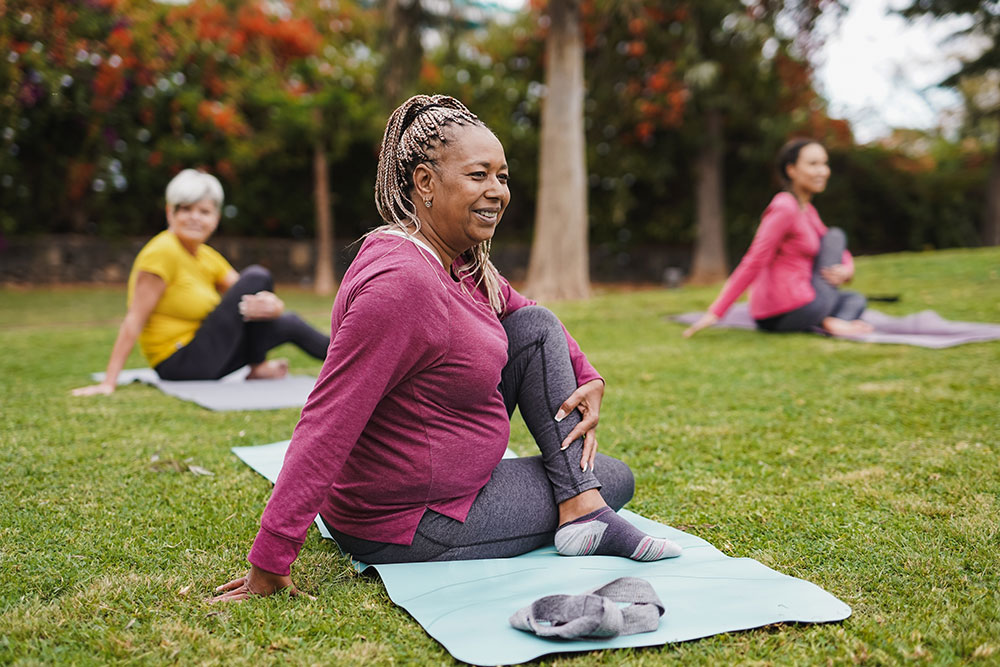
Mental health is different for everyone. It’s personal and complex; what helps one person manage theirs won’t necessarily help another. That said, there’s a proven link between our mental and physical health. Movement is medicine for our bodies and minds, so this Mental Health Awareness Week 2024, we’re all being encouraged to move more.
We’re proud to support the event and offer our own tips on promoting both physical and mental health at work.
Mental Health Awareness Week 2024 – Find Your Moments for Movement
Mental Health Awareness Week (MHAW) is an annual event organised by the Mental Health Foundation – a non-profit that’s been supporting the UK’s mental health since 1949.
The theme of this year’s event is “Movement: Moving more for our mental health.”
Movement is at the heart of the event because of the proven connection between physical and mental health. Exercise, sport, dance, a gentle stroll in nature – it’s all helpful.
But there’s another reason the event’s organisers are focusing on movement. Moving our bodies gives our brains a break from work, screens, bills and all the other everyday pressures that take priority over basic self-care. Whatever physical activity you choose, it helps to find a few minutes each day to do something entirely for yourself.
Of course, carving out this time is easier said than done, which is why the event also offers practical advice on building movement into your daily routine.
How Movement Helps Your Mental Health
It’s well known that our physical health can affect our mental health. We’ve all struggled to stay emotionally grounded after a restless night or felt invincible after a great workout.
Scientists have explored the connection between our bodies and minds for decades. They’ve conclusively proven that good physical health promotes good mental health. In simple terms, our brains release mood-boosting hormones when we’re physically active. And these hormones don’t just put us in a good mood. They’ve also been shown to:
- Reduce feelings of anxiety, stress and depression
- Improve quality of sleep
- Increase concentration and brain functions
Over time, the benefits accumulate. If you’re sleeping well, you’ll generally be more alert and sharper at work, so you’re more able to handle whatever comes your way. You’ll feel less stressed and have more energy for socialising, hobbies, self-care and other activities that help your mental health.

How Much You Need to Move
The government recommends that all adults engage in 150 minutes of moderate-intensity activity or 75 minutes of vigorous-intensity activity each week.
Moderate-intensity activity is anything where you’re breathing heavily while still being able to talk comfortably. Depending on your fitness levels, this includes cycling, walking or swimming.
Vigorous-intensity activity is anything where you’re breathing too fast to talk at a normal rate. For most people, this is running or playing a sport.
It’s also advisable to complete some kind of strength training two times a week. You don’t need to pump iron in your local weightlifting gym—bodyweight training, resistance bands and yoga all count. Working your muscles helps keep your body, bones and joints strong.
With this said, the government’s recommendation is a target. You should do everything realistic to achieve it. But when it comes to movement, some is always better than none.
Too many people are reluctant to start exercising because it’s intimidating. It’s easier to put it off because you feel you don’t have hours to spend down the gym or a good idea of where to begin.
Five minutes every day doing any physical activity you enjoy (dancing, gardening, skipping – whatever) is a great start. Even if this is all you ever manage, it’s still an achievement and better than nothing.
Starting with short bursts of regular activity also makes you more likely to stay consistent. It’s easier to keep something up when you make it a habit, so finding opportunities to move more during your workday is a smart strategy.
Moving More at Work
During the week, most of us spend the majority of our time working, which makes it harder to find opportunities to move. However, it is still possible to squeeze a few minutes of movement into a constructive workday.
Take Breaks
Start by using your lunch hour or any other regular breaks to get moving away from your desk or workplace.
Being out of your work environment helps take your mind off your to-do list and create space for more healthy thoughts. A walk in a park or somewhere similar is a great idea. The gentle exercise will help your body while the greenery will promote a more positive outlook.
Don’t be afraid to take short breaks throughout your day, either. Pausing work for a movement break will help you rack up those minutes of physical activity. And any time spent away from work can quickly be paid off by the resulting boosts in productivity. Taking 15 minutes up and away from your workstation for every 90 minutes concentrating is a good rule of thumb.

Combine Work and Movement
If you really can’t pause work, combining it with physical activity is one solution.
Any time up and out of your chair is beneficial, so why not skip the email and go find whomever you want to talk to? Seeking a face-to-face conversation is an excellent excuse for a walk, and it might even prove a better way to communicate.
You can also walk while you take your phone calls. If you’re anchored to a landline, standing is still better than sitting as it activates muscles in your core and legs.
Create Opportunities to Move
Any time spent waiting is also an opportunity to move. Boiling the kettle is a classic example. If you’ve got a few seconds to spare, spend them on your feet and moving.
You can also make life a little more physically demanding than it has to be. If you work in an office off the ground floor, take the stairs, not the lift. If you drive to work, park further away from the entrance than you have to. If you take the bus, get off at an earlier stop. A self-made two-minute inconvenience could be the start of better physical and mental health.
The Key Message
It can be challenging to change your lifestyle but remember that some movement is always better than none.
Start with what you can realistically achieve and maintain. Once your movement breaks become a habit, you can set new goals and build up to a full fitness programme over time. Or don’t. Do whatever’s manageable for you, and remember, even a slow start puts you ahead of where you were before.
Raising Mental Health Awareness
An unspoken theme of this year’s MHAW is the importance of ongoing self-care. Any positive changes inspired by the week-long event need to be sustained. It’s easier to do this when you understand mental health better and how to maintain it in tough times.
Our Mental Health Awareness Training explores common mental health struggles and support strategies. It improves understanding of stress, anxiety and depression and how they can worsen over time. You’ll be able to spot early warning signs in yourself and others and know what can be done to help.
About the author(s)






















































































































































































































































































































































































































































































































































